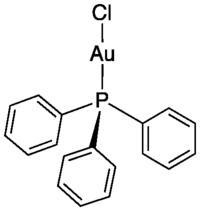Chloro(triphenylphosphine)gold(I)
Chloro(triphenylphosphine)gold(I) or triphenylphosphinegold(I) chloride is a coordination complex with the formula (Ph3P)AuCl. This colorless solid is a common reagent for research on gold compounds.
 | |
gold(I)-3D-spacefill.png) | |
| Identifiers | |
|---|---|
3D model (JSmol) |
|
| ChemSpider | |
| ECHA InfoCard | 100.034.636 |
| EC Number |
|
PubChem CID |
|
CompTox Dashboard (EPA) |
|
| |
| |
| Properties | |
| C18H15AuClP | |
| Molar mass | 494.71 g·mol−1 |
| Appearance | Colorless solid |
| Density | 1.97 g/cm3 |
| Melting point | 236–237 °C (457–459 °F; 509–510 K) |
| Hazards | |
| GHS pictograms |  |
| GHS Signal word | Warning |
GHS hazard statements |
H315, H319, H335 |
| P261, P264, P271, P280, P302+352, P304+340, P305+351+338, P312, P321, P332+313, P337+313, P362, P403+233, P405, P501 | |
Except where otherwise noted, data are given for materials in their standard state (at 25 °C [77 °F], 100 kPa). | |
| Infobox references | |
Preparation and structure
The complex is prepared by reducing chloroauric acid with triphenylphosphine in 95% ethanol:[1][2]
- HAuCl4 + H2O + 2 PPh3 → (Ph3P)AuCl + Ph3PO + 3 HCl
Ph3PAuCl can also be prepared by treating a thioether complex of gold like (dimethyl sulfide)gold(I) chloride, [(Me2S)AuCl], with triphenylphosphine.[3]
The complex adopts a linear coordination geometry, which is typical of most gold(I) compounds.[4] It crystallizes in the orthorhombic space group P212121 with a = 12.300(4) Å, b = 13.084(4) Å, c = 10.170(3) Å with Z = 4 formula units per unit cell. [5]
Reactivity
Triphenylphosphinegold(I) chloride is a popular stable precursor for a cationic gold(I) catalyst used in organic synthesis.[3] Typically, it is treated with silver(I) salts of weakly coordinating anions (e.g., X– = SbF6–, BF4–, TfO–, or Tf2N–) to generate a weakly bound Ph3PAu–X complex, in equilibrium with the catalytically-active species [Ph3PAu]+X– in solution. Among these, only the bistriflimide complex Ph3PAuNTf2 can be isolated as the pure compound.[6] The nitrate complex Ph3PAuONO2 and the oxonium species [(Ph3PAu)3O]+[BF4]– are also prepared from the chloride.[7]
As shown in the scheme below, the methyl complex Ph3PAuMe is prepared from triphenylphosphinegold(I) chloride by transmetalation with a Grignard reagent. Further treatment of Ph3PAuMe with methyllithium displaces the phosphine ligand and generates lithium dimethylaurate, Li+[AuMe2]–.
_and_gold(III)_organometallic_compounds.png)
References
- Pierre Braunstein, Hans Lehner, Dominique Matt "A Platinum-Gold Cluster: Chloro-1κCl-Bis(Triethylphosphine-1κP)Bis(Triphenylphosphine)-2κP, 3κP-Triangulo- Digold-Platinum(1 +) Trifluoromethanesulfonate" Inorganic Syntheses, 1990, Volume 27, Pages 218–221. doi: 10.1002/9780470132586.ch42
- M. I. Bruce, B. K. Nicholson, O. Bin Shawkataly (1989). "Synthesis of Gold-Containing Mixed-Metal Cluster Complexes". Inorganic Syntheses. Inorganic Syntheses. 26. pp. 324–328. doi:10.1002/9780470132579.ch59. ISBN 9780470132579.CS1 maint: uses authors parameter (link)
- Gorin, David J.; Sherry, Benjamin D.; Toste, F. Dean (2008), "Triphenylphosphinegold(I) chloride", Encyclopedia of Reagents for Organic Synthesis, American Cancer Society, doi:10.1002/047084289x.rn00803, ISBN 9780470842898
- Baenziger, N. C.; Bennett, W. E.; Soborofe, D. M. (1976). "Chloro(triphenylphosphine)gold(I)". Acta Crystallographica Section B. 32 (3): 962. doi:10.1107/S0567740876004330.
- Borissova, Alexandra O.; Korlyukov, Alexander A.; Antipin, Mikhail Yu.; Lyssenko, Konstantin A. (2008). "Estimation of Dissociation Energy in Donor−Acceptor Complex AuCl·PPh3via Topological Analysis of the Experimental Electron Density Distribution Function". The Journal of Physical Chemistry A. 112 (46): 11519–22. doi:10.1021/jp807258d. PMID 18959385.
- Mézailles, Nicolas; Ricard, Louis; Gagosz, Fabien (2005-09-01). "Phosphine Gold(I) Bis-(trifluoromethanesulfonyl)imidate Complexes as New Highly Efficient and Air-Stable Catalysts for the Cycloisomerization of Enynes". Organic Letters. 7 (19): 4133–4136. doi:10.1021/ol0515917. ISSN 1523-7060. PMID 16146370.
- A. M. Mueting, B. D. Alexander, P. D. Boyle, A. L. Casalnuovo, L. N. Ito, B. J. Johnson, L. H. Pignolet "Mixed-Metal-Gold Phosphine Cluster Compounds" Inorganic Syntheses, 1992, Volume 29, Pages 279–298, 2007. doi:10.1002/9780470132609.ch63